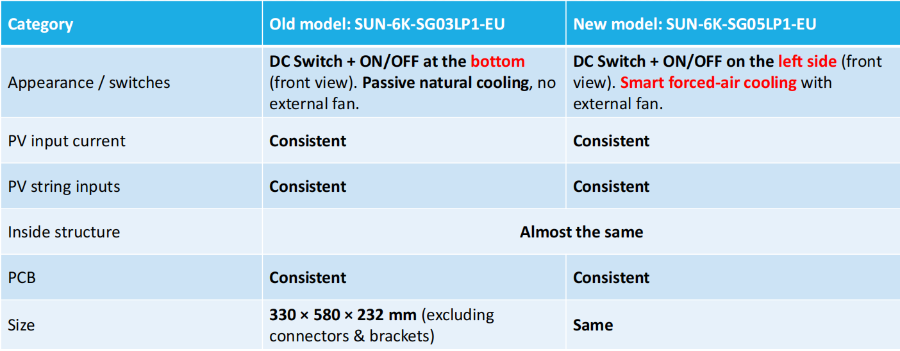-
 FAST SHIPPING
FAST SHIPPING
-
 COMPETITIVE PRICE
COMPETITIVE PRICE
-
 EXCELLENT AFTER-SERVICE
EXCELLENT AFTER-SERVICE
How to Set Up Solar Panels for an RV: A Practical Guide
Dec 09,2025How Do You Make Money From Solar Panels: Practical Strategies
Dec 05,2025How to Keep Snow Off Solar Panels: Practical Tips for Winter Care
Nov 24,2025How to Build a Solar Farm: Requirements, Costs & Risks
Nov 20,2025Avoid Refurbished Solar Panel Scams — How to Verify Second-Hand Panels
Nov 14,2025If you need to purchase related products, explore our inverter catalog or contact us directly for more options.
1. Appearance and Design Differences
The first noticeable difference between the two models lies in the design and cooling mechanisms.
Old Model (SUN-6K-SG03LP1-EU):
● The DC switch and ON/OFF switch are located at the bottom of the unit (when viewed from the front).
● The cooling system operates passively, relying on natural airflow to dissipate heat. Notably, this design does not feature an external cooling fan, which could impact performance in high-temperature conditions.
● The exterior design is clean with no visible external heat-dissipation fans, providing a more streamlined and aesthetically pleasing look.
New Model (SUN-6K-SG05LP1-EU):
● The DC switch and ON/OFF switch are now placed on the left side of the inverter (from the front view). This change likely improves accessibility and user convenience, especially in tight installation spaces.
● The cooling system has been upgraded to smart forced-air cooling, incorporating an external fan for better heat management. This system provides more efficient cooling, which is crucial for maintaining optimal inverter performance, especially in warm climates or high-load scenarios.
● The exterior of the new model accommodates the external fan, and the design now includes provisions for intake and exhaust clearance, suggesting a focus on heat management.
2. Technical Consistency
In terms of technical specifications, both models show a high degree of consistency:
● PV Input Current: Both models exhibit consistent performance, with no noticeable changes in current handling capacity.
● PV String Inputs: Again, both models maintain the same configuration, ensuring compatibility with existing installations.
● Inside Structure: The internal components of both inverters are almost the same, indicating that while the cooling and appearance have changed, the core functionality remains intact.
PCB and Size: The PCB design and physical size remain consistent between the two models, maintaining the same dimensions of 330 × 580 × 232 mm (excluding connectors and brackets). This ensures that installations can proceed without adjustments to mounting or space considerations.
3. Installer Impact
From an installation perspective, the new model offers some changes worth noting:
● The weight of the new model has decreased slightly from 25.0 kg (old) to 24.9 kg (new), which may make installation slightly easier.
● The airflow around the external fan needs to be carefully considered. It is essential to ensure there is enough space for air circulation to maintain cooling efficiency. Additionally, installers must evaluate the acoustic impact in quiet locations, as the external fan could generate more noise compared to the passive cooling system of the old model.
● Both models share the same physical dimensions, meaning no adjustments are needed for mounting or placement.
4. Summary of Key Differences

5. Conclusion
The transition from the Old model (SUN-6K-SG03LP1-EU) to the New model (SUN-6K-SG05LP1-EU) reflects improvements in cooling and user interface design, with the addition of forced-air cooling and a more accessible switch layout. These changes enhance both the performance and ease of use of the inverter. However, installers need to account for the potential noise impact from the new external fan and ensure proper clearance for efficient airflow. The core electrical components and dimensions remain largely unchanged, ensuring continuity and compatibility in installations.
These improvements cater to markets requiring higher cooling efficiency and those prioritizing ease of use and better accessibility in inverter design.
←
Foldable Photovoltaic Panels: A Transformative Step in Solar Energy
→
How to Connect an Inverter to a Battery: DIY Guide & Integrated Solutions
 +31610999937
+31610999937 [email protected]
[email protected] De Werf 11, 2544 EH The Hague, The Nederland.
De Werf 11, 2544 EH The Hague, The Nederland. WhatsApp: +1 (917) 257 2995/
WhatsApp: +1 (917) 257 2995/Copyright © 2023 Uni Z International B.V. VAT: NL864303440B01 All Rights Reserved
